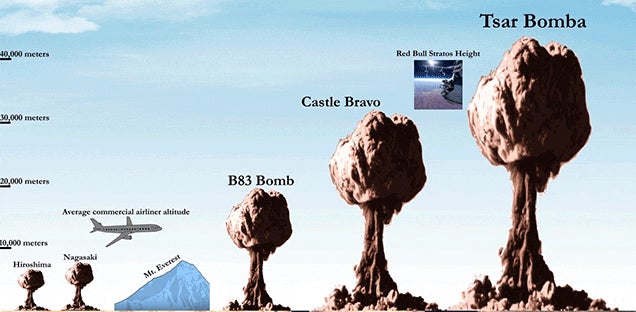


All in all, the bomb was built (and designed) by a small team of scientists and physicists in, and this is where sources are hazy, between 14 and 16 weeks… Seriously. So surely such a device was tens of months, if not years in the making, no? Of course it wasn’t, we’re talking about a country where popular alcoholic beverages are practically weapons grade. And this is after they reduced the total yield of the bomb by half. The bomb itself was so powerful that the survival rate for the pilot and crew aboard the plane that dropped it was estimated at 50%, and they were 10 km (about six miles) in the sky and 45 km (28 miles) away when the parachuted bomb detonated at an elevation of about 4 km (2.5 miles). once thought it would be fun to nuke the moon– basically, the bomb was little more than Russia demonstrating its military might and ingenuity it was simply too massive to be easily deployed in regular warfare, particularly nearly impossible for the Soviets to effectively deploy against the U.S. But why was such a device even made? Well, for similar reasons as to why the U.S.
#Tsar bomba blast radius archive
Fastfission created this image using the equations at Carey Sublette’s Nuclear Weapons Archive FAQ.The Tsar Bomba, or “Big Ivan” as the Soviets nicknamed it, is the single most powerful man-made explosive device in human history. Tsar Bomba was ten times more powerful than the explosive power of all the conventional weapons used in the Second World War.Ĭomparative fireball radii for a selection of nuclear weapons Image: Fastfission, via Wikimedia Commons.The seismic waves traveled three times around the world. Though the bomb was exploded 13,000 feet above the ground, its Richter Magnitude was registered at 5–5.25.The shock wave was felt by the people as far away as 692 km, and window glasses were shattered at a distance of 900 km from ground zero.The intense heat from the detonation was capable of causing third-degree burns at a distance of 62 miles from ground zero.It was about 3,333 times more powerful than the Little Boy. Thermal radiation radius: 77.06 km or covering 18626 square km.Airblast radius: 12.51 km or covering 491square km,.Radiation radius: 7.49 km or covering 176 Square km,.Fireball radius was 2.3 km or covering 16.61 square kilometers.The Soviet Union built the largest thermonuclear bomb in human history. Immense temperature and pressure from the initial fission reaction fuse the nuclei of hydrogen atoms and result in a much larger explosion. The secondary core is made of hydrogen isotopes like Tritium or Deuterium. In the beginning, it starts with a fission process like a normal A-bomb but the initial energy from the fission reaction then ignites a fusion reaction in a secondary core of the bomb. A hydrogen bomb uses both fission and fusion nuclear reactions. Hydrogen bombs are also known as thermonuclear weapons. H-Bomb (Hydrogen Bomb) is much more powerful than average Atom bombs. Department of Defense, via Wikimedia Commons It splits Uranium-235 or Plutonium-239 atoms to produce a large amount of destructive energy. This type of nuclear weapon goes through a fission reaction.


 0 kommentar(er)
0 kommentar(er)
